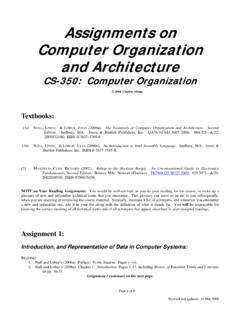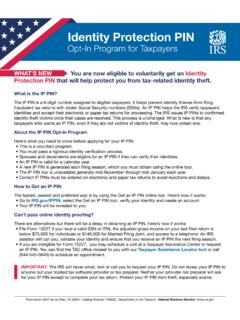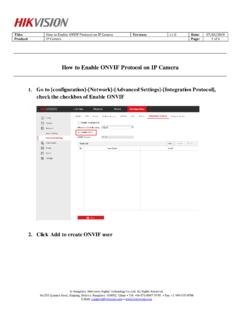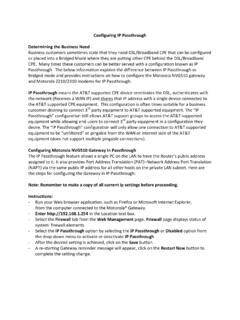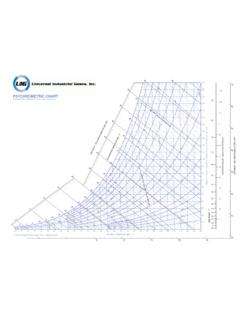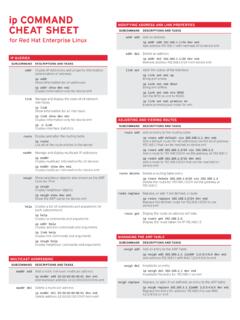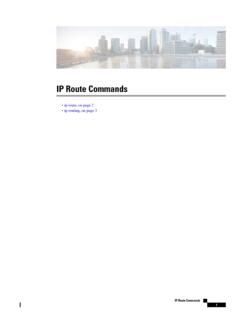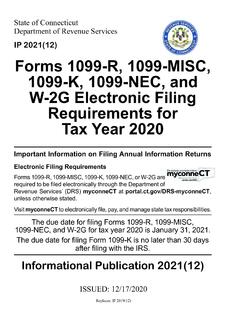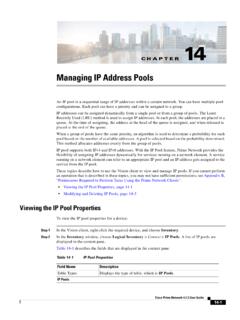Transcription of IP Addresses: Classful Addressing - JMU
1 The McGraw-Hill Companies, Inc., 2000 Adapted for use at JMU by Mohamed Aboutabl, 200311 Chapter 4IP Addresses: ClassfulAddressing The McGraw-Hill Companies, Inc., 2000 Adapted for use at JMU by Mohamed Aboutabl, 200322 CONTENTSCONTENTS INTRODUCTION Classful Addressing OTHER ISSUES A SAMPLE INTERNET The McGraw-Hill Companies, Inc., 2000 Adapted for use at JMU by Mohamed Aboutabl, Introduction An IP address is a 32-bit address that identifies a connection to the Internet. The IP addresses are universally unique. The address space of IPv4 is 232or 4,294,967,296. IP address is written as a Binary (hexadecimal) or a Dotted-Decimal (w/out leading zeros) notation.
2 See examples in the textbook. The McGraw-Hill Companies, Inc., 2000 Adapted for use at JMU by Mohamed Aboutabl, 200344 Classful The IP address space (all possible IP values) is divided into five classes: A, B, C, D, and The McGraw-Hill Companies, Inc., 2000 Adapted for use at JMU by Mohamed Aboutabl, 200355 Finding the class of an IP address11ststByte Byte decimal decimal valuesvalues0 0 --127127128128--191191192192--2232232242 24--239239240240--255255 The McGraw-Hill Companies, Inc., 2000 Adapted for use at JMU by Mohamed Aboutabl, 200366 Example 5 Example 5 How can we prove that we have 2,147,483,648 addresses in class A?
3 SolutionSolutionIn class A, only 1 bit defines the class. The remaining 31 bits are available for the address. With 31 bits, we can have 231or 2,147,483,648 addresses. The McGraw-Hill Companies, Inc., 2000 Adapted for use at JMU by Mohamed Aboutabl, 200377 Example 6 (Continued)Example 6 (Continued)Find the class of the address:11000001 10000011 00011011 11111111 SolutionSolutionThe first 2 bits are 1; the third bit is 0. This is a class C address. The McGraw-Hill Companies, Inc., 2000 Adapted for use at JMU by Mohamed Aboutabl, 200388 Example 7 Example 7 Find the class of the first byte is 227 (between 224 and 239); the class is D. The McGraw-Hill Companies, Inc.
4 , 2000 Adapted for use at JMU by Mohamed Aboutabl, 200399 Example 7 (Continued)Example 7 (Continued)Find the class of the first byte is 193 (between 192 and 223);the class is C. The McGraw-Hill Companies, Inc., 2000 Adapted for use at JMU by Mohamed Aboutabl, 20031010 Netidand hostid Only classes A, B, and C addresses are subdivided. Exercise: How many different Netid sand Host sin each of the classes A, B, C?Hostid s 2^24 = 16,777,216 2^16 = 65,536 2^8 = 256 Netid s 2^(8-1) = 128 2^(16-2) = 16,384 2^(24-3) = 2,097,152 The McGraw-Hill Companies, Inc., 2000 Adapted for use at JMU by Mohamed Aboutabl, 20031111 Blocks in class AMillions of class A addresses Millions of class A addresses are wasted.
5 Are wasted. One Block (One Block (NetidNetid10) is for Private 10) is for Private Addresses. Addresses. The McGraw-Hill Companies, Inc., 2000 Adapted for use at JMU by Mohamed Aboutabl, 20031212 Blocks in class BMany class B addresses Many class B addresses are Blocks are reserved for Private 16 Blocks are reserved for Private Addresses. Addresses. The McGraw-Hill Companies, Inc., 2000 Adapted for use at JMU by Mohamed Aboutabl, 20031313 Blocks in class CThe number of addresses in The number of addresses in a class C block is smaller than a class C block is smaller than the needs of most organizations. the needs of most organizations. 256 Blocks are reserved for 256 Blocks are reserved for Private Addresses.
6 Private Addresses. The McGraw-Hill Companies, Inc., 2000 Adapted for use at JMU by Mohamed Aboutabl, 20031414 Class D addresses (ONE block) Class D addresses (ONE block) are used for multicasting; are used for multicasting; Each address define one group. Each group member Each address define one group. Each group member has a multicast and a has a multicast and a unicastunicastIP addressIP addressClass E addresses (ONE block) are reserved for special Class E addresses (ONE block) are reserved for special purposes (limited broadcast) ; most of the block is purposes (limited broadcast) ; most of the block is wasted. wasted. The McGraw-Hill Companies, Inc.
7 , 2000 Adapted for use at JMU by Mohamed Aboutabl, 20031515 Network AddressesNetwork network address is the first address in the network address defines the network to the rest of the Internet. the network address, we can find the class of the address, the block, and the range of the addresses in the block The McGraw-Hill Companies, Inc., 2000 Adapted for use at JMU by Mohamed Aboutabl, 20031616 Example 9 Example 9 Given the network address , find the class, the block, and the range of the class is A because the first byte is between 0 and 127. The block has a netidof 17. The addresses range from to The McGraw-Hill Companies, Inc., 2000 Adapted for use at JMU by Mohamed Aboutabl, 20031717 Example 10 Example 10 Given the network address , find the class, the block, and the range of the class is B because the first byte is between 128 and 191.
8 The block has a netidof The addresses range from to The McGraw-Hill Companies, Inc., 2000 Adapted for use at JMU by Mohamed Aboutabl, 20031818 Example 11 Example 11 Given the network address , find the class, the block, and the range of the class is C because the first byte is between 192 and 223. The block has a netidof The addresses range from to The McGraw-Hill Companies, Inc., 2000 Adapted for use at JMU by Mohamed Aboutabl, 20031919IP address Network the class, then the Netid, then set Hostid= 0 Example: IP= is a class B (128-191) with Netid= , so its network address is a Mask which is a 32-bit binary number that gives the first address in the block (the network address) when bitwise ANDedwith an address in the block.
9 The McGraw-Hill Companies, Inc., 2000 Adapted for use at JMU by Mohamed Aboutabl, 20032020 Default in dotted-decimalClass The McGraw-Hill Companies, Inc., 2000 Adapted for use at JMU by Mohamed Aboutabl, 20032121 The network address is the The network address is the beginning address of each address of each can be found by applying It can be found by applying the default mask tothe default mask toany of the addresses in the block any of the addresses in the block (including itself).(including itself).It retains the It retains the netidnetidof the block of the block and sets the and sets the hostidhostidto zero. to zero. The McGraw-Hill Companies, Inc.
10 , 2000 Adapted for use at JMU by Mohamed Aboutabl, 20032222 Example 12 Example 12 Given the address and the default class A mask, find the beginning address (network address).SolutionSolutionThe default mask is , which means that only the first byte is preserved and the other 3 bytes are set to 0s. The network address is The McGraw-Hill Companies, Inc., 2000 Adapted for use at JMU by Mohamed Aboutabl, 20032323 Example 13 Example 13 Given the address and the default class B mask, find the beginning address (network address).SolutionSolutionThe default mask is , which means that the first 2 bytes are preserved and the other 2 bytes are set to 0s.
